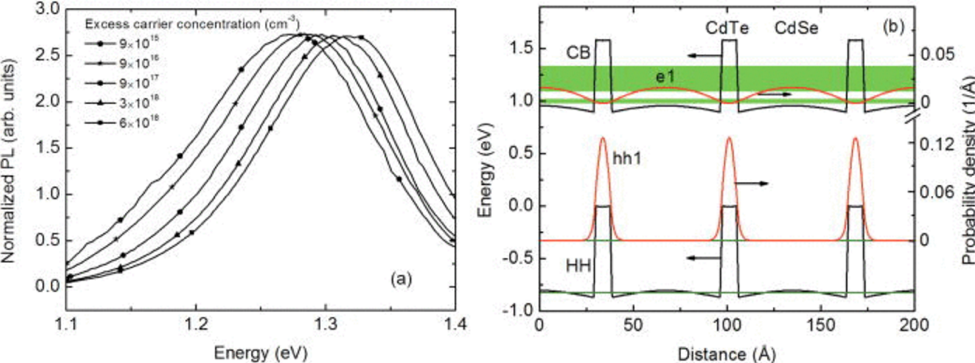J.-J. Li, L. et al., Applied Physics Letters 101, 061915-061915. (2012)
CdSe/CdTe type-II superlattices grown on GaSb substrates by molecular beam epitaxy are studied using time-resolved and steady-state photoluminescence (PL) spectroscopy at 10 K. A carrier lifetime of 188 ns is observed in time-resolved PL measurements. The steady-state PL peak position exhibits a blue shift with increasing excess carrier concentration. This effect can be explained by band bending as a result of the spatial separation of electrons and holes, which is critical confirmation of a strong type-II band edge alignment between CdSe and CdTe.
J.-J. Li, et al., Appl. Phys. Lett. 100, 121908 (2012).
CdSe/CdTe superlattices are grown on GaSb substrates using molecular beam epitaxy. X-ray diffraction measurements and cross-sectional transmission electron microscopy images indicate high crystalline quality. Photoluminescence (PL) measurements show the effective bandgap varies with the superlattice layer thicknesses and confirm the CdSe/CdTe heterostructure has a type-II band edge alignment. These results suggest that CdSe/CdTe superlattices are promising candidates for multi-junction solar cells and other optoelectronic devices based on GaSb substrates.
M. J. DiNezza, et al., Applied Physics Letters 103, 193901 (2013).
CdTe/MgCdTe double heterostructures (DHs) are grown on InSb substrates using molecular beam epitaxy and reveal strong photoluminescence with over double the intensity of a GaAs/AlGaAs DH with an identical layer structure design grown on GaAs. Time-resolved photoluminescence of the CdTe/MgCdTe DH gives a Shockley-Read-Hall recombination lifetime of 86 ns, which is more than one order of magnitude longer than that of typical polycrystalline CdTe films.
X.-H. Zhao, et al., Appl. Phys. Letters 105, 252101 (2014).
The bulk Shockley-Read-Hall carrier lifetime of CdTe and interface recombination velocity at the CdTe/Mg0.24Cd0.76Te heterointerface are estimated to be around 0.5 µs and (4.7 ± 0.4) 102 cm/s, respectively, using time-resolved photoluminescence (PL) measurements. Double heterostructures (DHs) with varying CdTe layer thicknesses were grown on nearly lattice-matched InSb (001) substrates using molecular beam epitaxy. The longest lifetime of 179 ns is observed in the DH with a 2 µm thick CdTe layer. It is also shown that the photon recycling effect has a strong influence on the bulk radiative lifetime.
X.-H. Zhao, et al., Journal of Vacuum Science & Technology B 32, 040601 (2014).
This Letter reports the optical properties of CdTe/MgCdTe double heterostructures grown by molecular beam epitaxy. Low-temperature photoluminescence shows strong band-to-band emission and very weak defect related peaks, indicating low defect densities. The measured Shockley–Read–Hall lifetimes range from 57 to 86 ns at room temperature for samples grown under different conditions.
S. Liu, et al., Appl. Phys. Letters 107, 041120 (2015).
The interface recombination velocities of CdTe/MgxCd1−xTe double heterostructure (DH) samples with different CdTe layer thicknesses and Mg compositions are studied using time-resolved photoluminescence measurements. A lowest interface recombination velocity of 30 ± 10 cm/s has been measured for the CdTe/Mg0.46Cd0.54Te interface, and a longest carrier lifetime of 0.83 μs has been observed for the studied DHs.
S. Liu, et al., J. Vac. Sci. Technol. B 33, 011207 (2015).
A CdZnTe/MgCdTe double-heterostructure (DH) consisting of a 3 µm thick Cd0.9946Zn0.0054Te middle layer that is lattice-matched to an InSb substrate has been grown using molecular beam epitaxy. A long carrier lifetime of 3.4 x 102 ns has been demonstrated at room temperature, which is approximately three times as long as that of a CdTe/MgCdTe DH with identical layer thickness. This substantial improvement is due to the reduction in misfit dislocation density in the CdZnTe alloy.
Y. Zhao, et al., Nature Energy (2016).
Recently we reported a monocrystalline CdTe/MgCdTe double-heterostructure solar cell with open-circuit voltages of up to 1.096 V. The latticed-matched MgCdTe barrier layers provide excellent passivation to the CdTe absorber, resulting in a carrier lifetime of 3.6 μs. The solar cells are made of 1- to 1.5-μm-thick n-type CdTe absorbers, and passivated hole-selective p-type a-SiCy:H contacts. This design allows CdTe solar cells to be made thinner and more efficient. The best power conversion efficiency achieved in a device with this structure is 17.0%.



